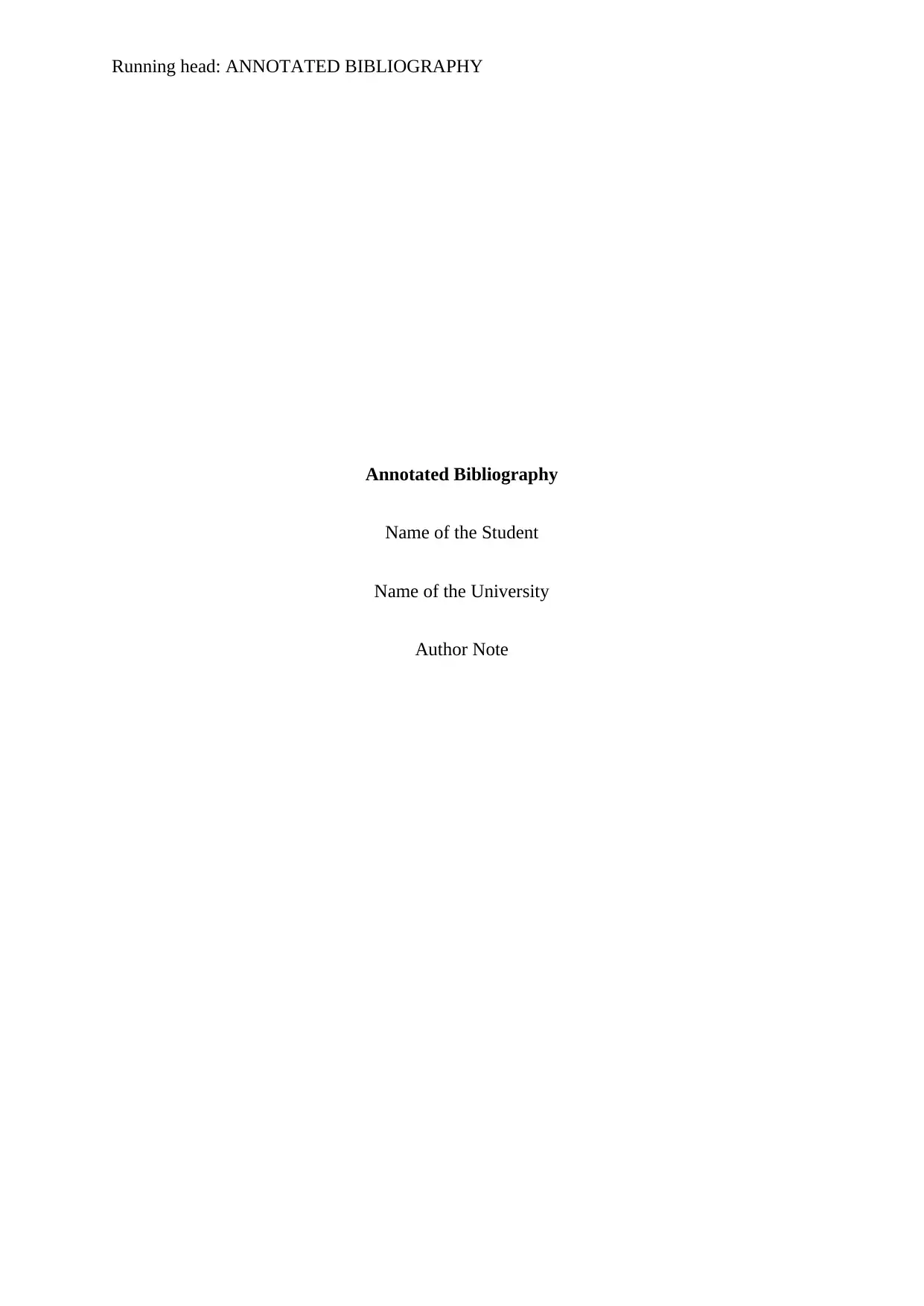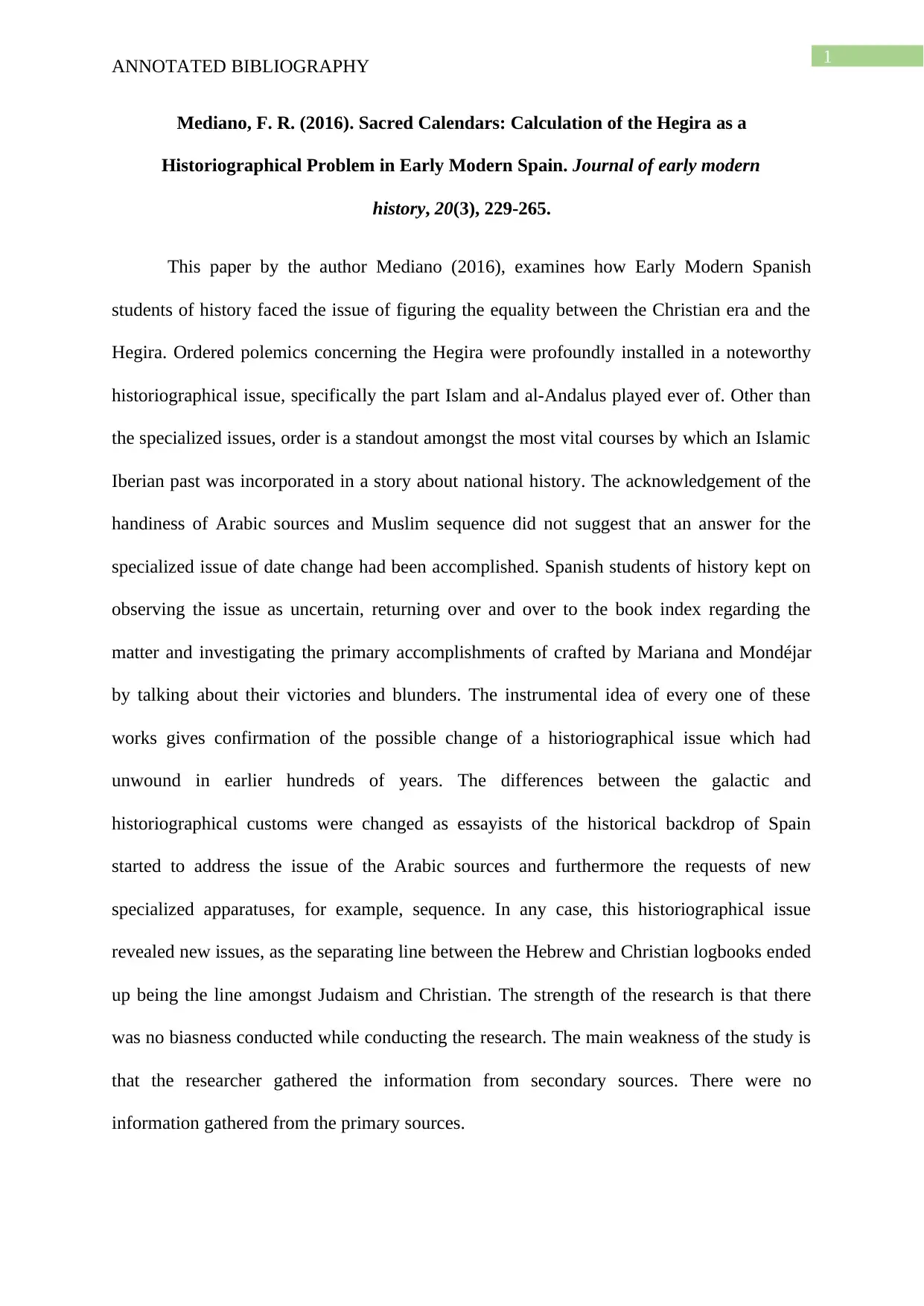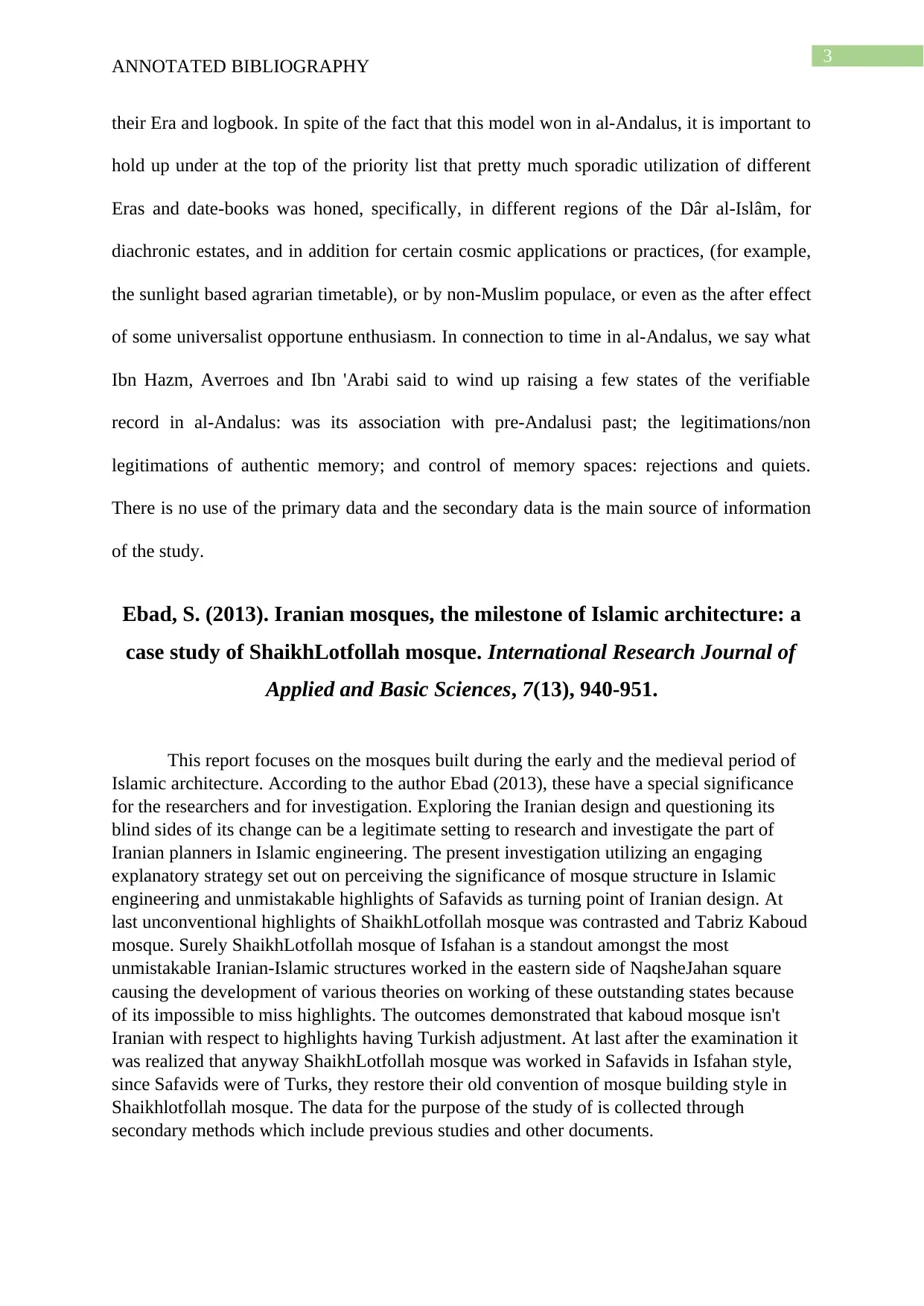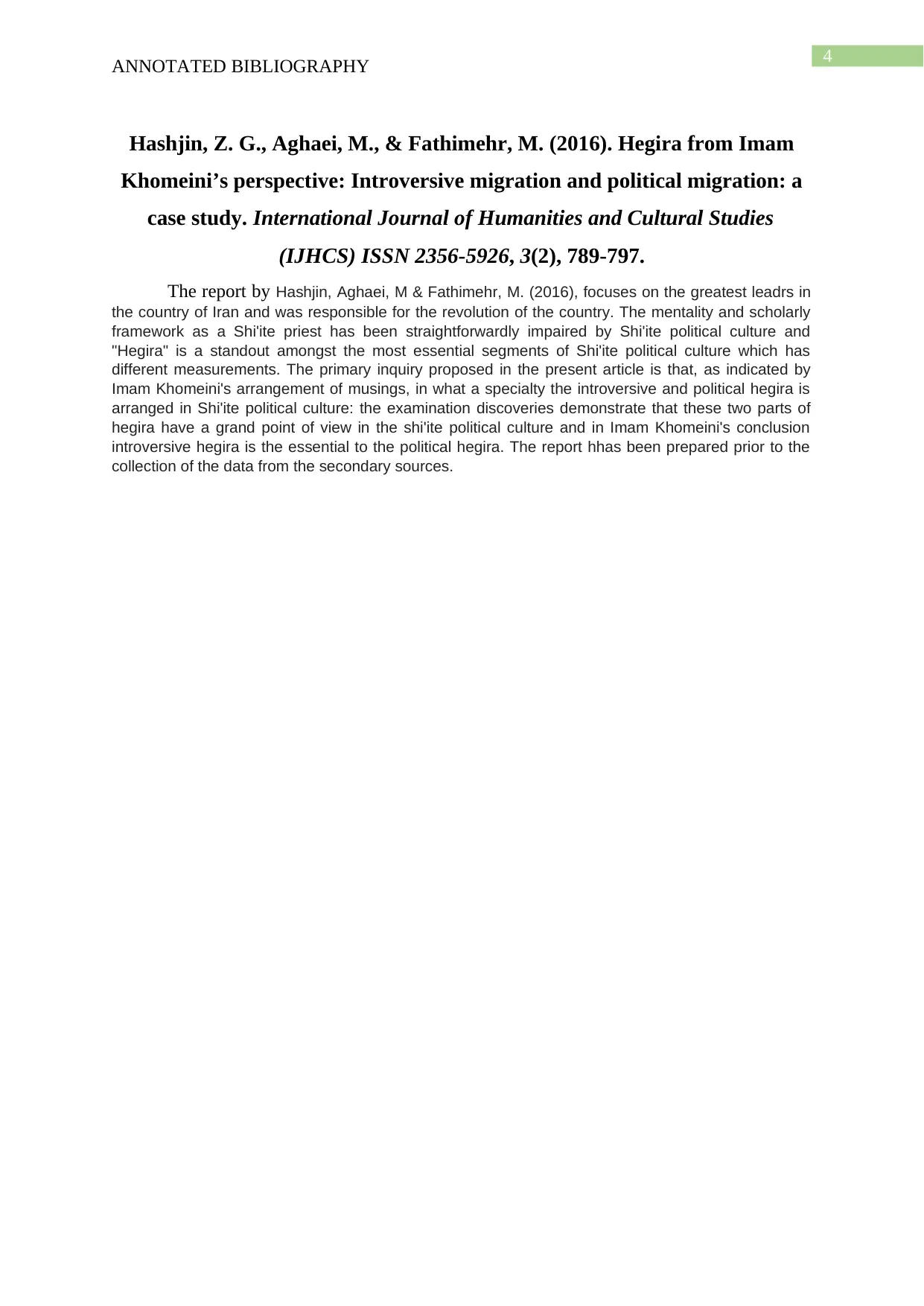Annotated Bibliography on Islamic History and Architecture
VerifiedAdded on 2023/06/10
|6
|1577
|83
AI Summary
This annotated bibliography explores the topics of Islamic history and architecture including the calculation of Hegira, urban development, Iranian mosques, and more. The research is conducted using secondary sources, and the strengths and weaknesses of each study are discussed.
Contribute Materials
Your contribution can guide someone’s learning journey. Share your
documents today.

Running head: ANNOTATED BIBLIOGRAPHY
Annotated Bibliography
Name of the Student
Name of the University
Author Note
Annotated Bibliography
Name of the Student
Name of the University
Author Note
Secure Best Marks with AI Grader
Need help grading? Try our AI Grader for instant feedback on your assignments.

1
ANNOTATED BIBLIOGRAPHY
Mediano, F. R. (2016). Sacred Calendars: Calculation of the Hegira as a
Historiographical Problem in Early Modern Spain. Journal of early modern
history, 20(3), 229-265.
This paper by the author Mediano (2016), examines how Early Modern Spanish
students of history faced the issue of figuring the equality between the Christian era and the
Hegira. Ordered polemics concerning the Hegira were profoundly installed in a noteworthy
historiographical issue, specifically the part Islam and al-Andalus played ever of. Other than
the specialized issues, order is a standout amongst the most vital courses by which an Islamic
Iberian past was incorporated in a story about national history. The acknowledgement of the
handiness of Arabic sources and Muslim sequence did not suggest that an answer for the
specialized issue of date change had been accomplished. Spanish students of history kept on
observing the issue as uncertain, returning over and over to the book index regarding the
matter and investigating the primary accomplishments of crafted by Mariana and Mondéjar
by talking about their victories and blunders. The instrumental idea of every one of these
works gives confirmation of the possible change of a historiographical issue which had
unwound in earlier hundreds of years. The differences between the galactic and
historiographical customs were changed as essayists of the historical backdrop of Spain
started to address the issue of the Arabic sources and furthermore the requests of new
specialized apparatuses, for example, sequence. In any case, this historiographical issue
revealed new issues, as the separating line between the Hebrew and Christian logbooks ended
up being the line amongst Judaism and Christian. The strength of the research is that there
was no biasness conducted while conducting the research. The main weakness of the study is
that the researcher gathered the information from secondary sources. There were no
information gathered from the primary sources.
ANNOTATED BIBLIOGRAPHY
Mediano, F. R. (2016). Sacred Calendars: Calculation of the Hegira as a
Historiographical Problem in Early Modern Spain. Journal of early modern
history, 20(3), 229-265.
This paper by the author Mediano (2016), examines how Early Modern Spanish
students of history faced the issue of figuring the equality between the Christian era and the
Hegira. Ordered polemics concerning the Hegira were profoundly installed in a noteworthy
historiographical issue, specifically the part Islam and al-Andalus played ever of. Other than
the specialized issues, order is a standout amongst the most vital courses by which an Islamic
Iberian past was incorporated in a story about national history. The acknowledgement of the
handiness of Arabic sources and Muslim sequence did not suggest that an answer for the
specialized issue of date change had been accomplished. Spanish students of history kept on
observing the issue as uncertain, returning over and over to the book index regarding the
matter and investigating the primary accomplishments of crafted by Mariana and Mondéjar
by talking about their victories and blunders. The instrumental idea of every one of these
works gives confirmation of the possible change of a historiographical issue which had
unwound in earlier hundreds of years. The differences between the galactic and
historiographical customs were changed as essayists of the historical backdrop of Spain
started to address the issue of the Arabic sources and furthermore the requests of new
specialized apparatuses, for example, sequence. In any case, this historiographical issue
revealed new issues, as the separating line between the Hebrew and Christian logbooks ended
up being the line amongst Judaism and Christian. The strength of the research is that there
was no biasness conducted while conducting the research. The main weakness of the study is
that the researcher gathered the information from secondary sources. There were no
information gathered from the primary sources.

2
ANNOTATED BIBLIOGRAPHY
Keser, A., & Kurt, E. (2015) The Contributions of Waqfs and Urban Development to
the Settlement of Public Health Services: An Overview to Turkish Administrative
History of Anatolian Seljuks.
The authors of the research Kesar & Kurt (2015), views that amid the time of
Anatolian Seljuks, an incredible significance was given to the urban advancement as the
financial, political or military focuses with a combination of Islamic, Turkish, Byzantine and
Persian societies. Unique care was taken of the presentation of open administrations,
particularly the wellbeing administrations that have never been disregarded. Seljuks have
considered pharmaceutical of most extreme significance and have contributed altogether to
development. Amid the Seljuk time frame, a great deal of spearheading madrasahs has been
established as a continuum of the Islamic history with critical commitments likewise
influencing the Ottoman culture as a successor. It is assessed that, as on account of every
open administration of the period, the association and presentation of the well-being
administrations had likewise close connection with the urban improvement and waqf
(establishments). Henceforth in this investigation it is intended to explore the organizing
identified with the presentation of the wellbeing administrations amid the previously
mentioned period inside the extent of waqfs and urban advancement by an exploration
procedure through unique chronicle records. The major strength of the article is that the
researcher has described the facts very clearly and the research is free from any kind of bias.
The major weakness being lack of use of the primary data while conducting the research
Viguera Molins, M. J. (2016). Tiempo, historia, memoria en Al-Andalus.
In the eyes of Viguera Molins (2016), the idea of time in Islam, set apart by
the foundation of an appropriate time, started with the Prophet Muhammad's departure from
Mecca to Medina, which is set not long after as year 1 of the Hegira (622 a.C.), to constitute
ANNOTATED BIBLIOGRAPHY
Keser, A., & Kurt, E. (2015) The Contributions of Waqfs and Urban Development to
the Settlement of Public Health Services: An Overview to Turkish Administrative
History of Anatolian Seljuks.
The authors of the research Kesar & Kurt (2015), views that amid the time of
Anatolian Seljuks, an incredible significance was given to the urban advancement as the
financial, political or military focuses with a combination of Islamic, Turkish, Byzantine and
Persian societies. Unique care was taken of the presentation of open administrations,
particularly the wellbeing administrations that have never been disregarded. Seljuks have
considered pharmaceutical of most extreme significance and have contributed altogether to
development. Amid the Seljuk time frame, a great deal of spearheading madrasahs has been
established as a continuum of the Islamic history with critical commitments likewise
influencing the Ottoman culture as a successor. It is assessed that, as on account of every
open administration of the period, the association and presentation of the well-being
administrations had likewise close connection with the urban improvement and waqf
(establishments). Henceforth in this investigation it is intended to explore the organizing
identified with the presentation of the wellbeing administrations amid the previously
mentioned period inside the extent of waqfs and urban advancement by an exploration
procedure through unique chronicle records. The major strength of the article is that the
researcher has described the facts very clearly and the research is free from any kind of bias.
The major weakness being lack of use of the primary data while conducting the research
Viguera Molins, M. J. (2016). Tiempo, historia, memoria en Al-Andalus.
In the eyes of Viguera Molins (2016), the idea of time in Islam, set apart by
the foundation of an appropriate time, started with the Prophet Muhammad's departure from
Mecca to Medina, which is set not long after as year 1 of the Hegira (622 a.C.), to constitute

3
ANNOTATED BIBLIOGRAPHY
their Era and logbook. In spite of the fact that this model won in al-Andalus, it is important to
hold up under at the top of the priority list that pretty much sporadic utilization of different
Eras and date-books was honed, specifically, in different regions of the Dâr al-Islâm, for
diachronic estates, and in addition for certain cosmic applications or practices, (for example,
the sunlight based agrarian timetable), or by non-Muslim populace, or even as the after effect
of some universalist opportune enthusiasm. In connection to time in al-Andalus, we say what
Ibn Hazm, Averroes and Ibn 'Arabi said to wind up raising a few states of the verifiable
record in al-Andalus: was its association with pre-Andalusi past; the legitimations/non
legitimations of authentic memory; and control of memory spaces: rejections and quiets.
There is no use of the primary data and the secondary data is the main source of information
of the study.
Ebad, S. (2013). Iranian mosques, the milestone of Islamic architecture: a
case study of ShaikhLotfollah mosque. International Research Journal of
Applied and Basic Sciences, 7(13), 940-951.
This report focuses on the mosques built during the early and the medieval period of
Islamic architecture. According to the author Ebad (2013), these have a special significance
for the researchers and for investigation. Exploring the Iranian design and questioning its
blind sides of its change can be a legitimate setting to research and investigate the part of
Iranian planners in Islamic engineering. The present investigation utilizing an engaging
explanatory strategy set out on perceiving the significance of mosque structure in Islamic
engineering and unmistakable highlights of Safavids as turning point of Iranian design. At
last unconventional highlights of ShaikhLotfollah mosque was contrasted and Tabriz Kaboud
mosque. Surely ShaikhLotfollah mosque of Isfahan is a standout amongst the most
unmistakable Iranian-Islamic structures worked in the eastern side of NaqsheJahan square
causing the development of various theories on working of these outstanding states because
of its impossible to miss highlights. The outcomes demonstrated that kaboud mosque isn't
Iranian with respect to highlights having Turkish adjustment. At last after the examination it
was realized that anyway ShaikhLotfollah mosque was worked in Safavids in Isfahan style,
since Safavids were of Turks, they restore their old convention of mosque building style in
Shaikhlotfollah mosque. The data for the purpose of the study of is collected through
secondary methods which include previous studies and other documents.
ANNOTATED BIBLIOGRAPHY
their Era and logbook. In spite of the fact that this model won in al-Andalus, it is important to
hold up under at the top of the priority list that pretty much sporadic utilization of different
Eras and date-books was honed, specifically, in different regions of the Dâr al-Islâm, for
diachronic estates, and in addition for certain cosmic applications or practices, (for example,
the sunlight based agrarian timetable), or by non-Muslim populace, or even as the after effect
of some universalist opportune enthusiasm. In connection to time in al-Andalus, we say what
Ibn Hazm, Averroes and Ibn 'Arabi said to wind up raising a few states of the verifiable
record in al-Andalus: was its association with pre-Andalusi past; the legitimations/non
legitimations of authentic memory; and control of memory spaces: rejections and quiets.
There is no use of the primary data and the secondary data is the main source of information
of the study.
Ebad, S. (2013). Iranian mosques, the milestone of Islamic architecture: a
case study of ShaikhLotfollah mosque. International Research Journal of
Applied and Basic Sciences, 7(13), 940-951.
This report focuses on the mosques built during the early and the medieval period of
Islamic architecture. According to the author Ebad (2013), these have a special significance
for the researchers and for investigation. Exploring the Iranian design and questioning its
blind sides of its change can be a legitimate setting to research and investigate the part of
Iranian planners in Islamic engineering. The present investigation utilizing an engaging
explanatory strategy set out on perceiving the significance of mosque structure in Islamic
engineering and unmistakable highlights of Safavids as turning point of Iranian design. At
last unconventional highlights of ShaikhLotfollah mosque was contrasted and Tabriz Kaboud
mosque. Surely ShaikhLotfollah mosque of Isfahan is a standout amongst the most
unmistakable Iranian-Islamic structures worked in the eastern side of NaqsheJahan square
causing the development of various theories on working of these outstanding states because
of its impossible to miss highlights. The outcomes demonstrated that kaboud mosque isn't
Iranian with respect to highlights having Turkish adjustment. At last after the examination it
was realized that anyway ShaikhLotfollah mosque was worked in Safavids in Isfahan style,
since Safavids were of Turks, they restore their old convention of mosque building style in
Shaikhlotfollah mosque. The data for the purpose of the study of is collected through
secondary methods which include previous studies and other documents.
Paraphrase This Document
Need a fresh take? Get an instant paraphrase of this document with our AI Paraphraser

4
ANNOTATED BIBLIOGRAPHY
Hashjin, Z. G., Aghaei, M., & Fathimehr, M. (2016). Hegira from Imam
Khomeini’s perspective: Introversive migration and political migration: a
case study. International Journal of Humanities and Cultural Studies
(IJHCS) ISSN 2356-5926, 3(2), 789-797.
The report by Hashjin, Aghaei, M & Fathimehr, M. (2016), focuses on the greatest leadrs in
the country of Iran and was responsible for the revolution of the country. The mentality and scholarly
framework as a Shi'ite priest has been straightforwardly impaired by Shi'ite political culture and
"Hegira" is a standout amongst the most essential segments of Shi'ite political culture which has
different measurements. The primary inquiry proposed in the present article is that, as indicated by
Imam Khomeini's arrangement of musings, in what a specialty the introversive and political hegira is
arranged in Shi'ite political culture: the examination discoveries demonstrate that these two parts of
hegira have a grand point of view in the shi'ite political culture and in Imam Khomeini's conclusion
introversive hegira is the essential to the political hegira. The report hhas been prepared prior to the
collection of the data from the secondary sources.
ANNOTATED BIBLIOGRAPHY
Hashjin, Z. G., Aghaei, M., & Fathimehr, M. (2016). Hegira from Imam
Khomeini’s perspective: Introversive migration and political migration: a
case study. International Journal of Humanities and Cultural Studies
(IJHCS) ISSN 2356-5926, 3(2), 789-797.
The report by Hashjin, Aghaei, M & Fathimehr, M. (2016), focuses on the greatest leadrs in
the country of Iran and was responsible for the revolution of the country. The mentality and scholarly
framework as a Shi'ite priest has been straightforwardly impaired by Shi'ite political culture and
"Hegira" is a standout amongst the most essential segments of Shi'ite political culture which has
different measurements. The primary inquiry proposed in the present article is that, as indicated by
Imam Khomeini's arrangement of musings, in what a specialty the introversive and political hegira is
arranged in Shi'ite political culture: the examination discoveries demonstrate that these two parts of
hegira have a grand point of view in the shi'ite political culture and in Imam Khomeini's conclusion
introversive hegira is the essential to the political hegira. The report hhas been prepared prior to the
collection of the data from the secondary sources.

5
ANNOTATED BIBLIOGRAPHY
REFERENCES
Ebad, S. (2013). Iranian mosques, the milestone of Islamic architecture: a case study of
ShaikhLotfollah mosque. International Research Journal of Applied and Basic
Sciences, 7(13), 940-951.
Hashjin, Z. G., Aghaei, M., & Fathimehr, M. (2016). Hegira from Imam Khomeini’s
perspective: Introversive migration and political migration: a case
study. International Journal of Humanities and Cultural Studies (IJHCS) ISSN 2356-
5926, 3(2), 789-797.
Keser, A., & Kurt, E. (2015) The Contributions of Waqfs and Urban Development to the
Settlement of Public Health Services: An Overview to Turkish Administrative History
of Anatolian Seljuks.
Mediano, F. R. (2016). Sacred Calendars: Calculation of the Hegira as a Historiographical
Problem in Early Modern Spain. Journal of early modern history, 20(3), 229-265.
Viguera Molins, M. J. (2016). Tiempo, historia, memoria en Al-Andalus.
ANNOTATED BIBLIOGRAPHY
REFERENCES
Ebad, S. (2013). Iranian mosques, the milestone of Islamic architecture: a case study of
ShaikhLotfollah mosque. International Research Journal of Applied and Basic
Sciences, 7(13), 940-951.
Hashjin, Z. G., Aghaei, M., & Fathimehr, M. (2016). Hegira from Imam Khomeini’s
perspective: Introversive migration and political migration: a case
study. International Journal of Humanities and Cultural Studies (IJHCS) ISSN 2356-
5926, 3(2), 789-797.
Keser, A., & Kurt, E. (2015) The Contributions of Waqfs and Urban Development to the
Settlement of Public Health Services: An Overview to Turkish Administrative History
of Anatolian Seljuks.
Mediano, F. R. (2016). Sacred Calendars: Calculation of the Hegira as a Historiographical
Problem in Early Modern Spain. Journal of early modern history, 20(3), 229-265.
Viguera Molins, M. J. (2016). Tiempo, historia, memoria en Al-Andalus.
1 out of 6
![[object Object]](/_next/static/media/star-bottom.7253800d.svg)